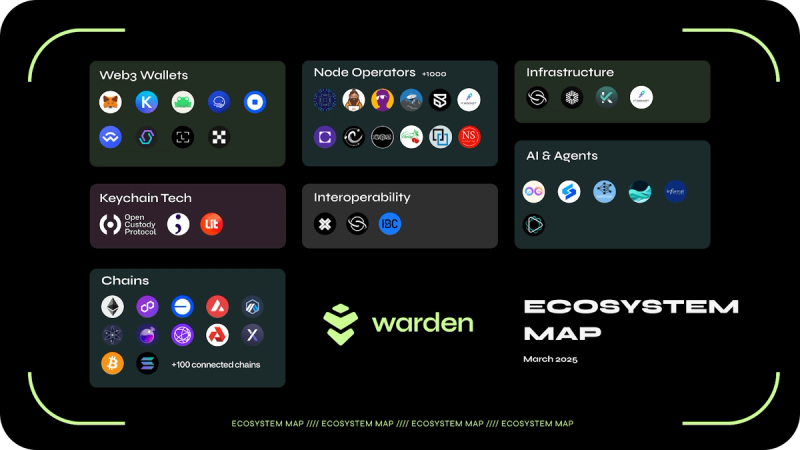Key Insights
- Warden Protocol is a Layer-1 blockchain enabling verifiable and safe AI integration across a multitude of blockchains (over 100 networks as of early 2025). A core goal is to bring artificial intelligence onchain with cryptographic guarantees, so that AI outputs can be trusted and used in onchain decisions.
- Warden Protocol’s founding team brings deep expertise from both the blockchain and technology sectors. The team includes veterans with backgrounds at Binance, Uber, Google X, and NASA, as well as former contributors to Cosmos.
- The Warden Agent Kit (WAK) is a toolkit for building smart contract-native AI agents. Unlike competitors that connect AI to blockchains via oracles, WAK enables AI models to operate natively within onchain logic. Developers can use WAK to create agents that autonomously execute contract functions based on AI inferences.
- Warden Protocol has cultivated a broad ecosystem of partners across interoperability, data, AI computing, security, and more. Notable partners include Axelar, Evmos, Kyve, and Skip Protocol.
- Warden Protocol’s roadmap focuses on bringing the most expressive compute onchain (including AI), and user accessibility. Two major developments are set to define its future: x/async, and the Warden App.
Protocol Overview
Warden Protocol is a Layer-1 blockchain purpose-built for AI-integrated applications. It enables any smart contract to access and verify AI models, bringing artificial intelligence onchain with cryptographic guarantees. Warden is structured across three layers: a base chain with x/async for offchain compute access, an intelligence layer powered by SPEx for verifying AI outputs, and an application layer with tools and primitives for building AI-native applications.
Unlike traditional blockchains, Warden includes a verifiable computing protocol—SPEx—that ensures the integrity of computational tasks, including non-deterministic outputs like LLM inferences. SPEx acts as a firewall for AI, using probabilistic sampling and cryptographic proofs to validate model execution across a decentralized validator set. This infrastructure allows onchain applications to safely and confidently integrate AI outputs.
Warden Protocol’s founding team brings deep expertise from both the blockchain and technology sectors. The core leadership includes CEO David Pinger (ex-Binance, ex-Uber), Chief AI Officer Dr. Michele Dallachiesa (ex-Google, ex-NASA), and Chief Blockchain Developer Antonio Pitasi (ex-Ignite/Tendermint). They are joined by Engineering Lead Dr. Andrei Sambra (ex-Nillion, W3C, MIT), as well as Co-Founders Josh Goodbody and Luis Vaello, both previously executives at Binance and Qredo, who lead operational and commercial efforts from the Warden Foundation. In total, the team includes over a dozen professionals with backgrounds across crypto, AI, and enterprise technology.
Warden Agent Kit
The Warden Agent Kit (WAK) is a toolkit for building smart contract-native AI agents. Unlike competitors that connect AI to blockchains via oracles, WAK enables AI models to operate natively within onchain logic, making AI an active participant in blockchain transactions.
Developers can use WAK to create agents that autonomously execute contract functions based on AI inferences. For example, an agent could monitor markets and execute trades based on machine learning predictions. While AI computation occurs offchain, results are verified onchain, ensuring trustless execution.
WAK also provides secure key management through Warden’s “keychains” system, allowing AI agents to control private keys and sign transactions securely. This innovation enables AI-driven protocols to function transparently and autonomously, integrating AI decision-making directly into blockchain operations.
The future direction of WAK is to see each Warden Agent embodied by a smart contract, enabling users to connect their wallets and interact with agents in a fully non-custodial way.
SPEx (Statistical Proof of Execution)
Warden’s SPEx (Statistical Proof of Execution) forms its intelligence layer, it ensures AI models can be trusted onchain by using statistical sampling and consensus instead of resource-intensive zero-knowledge proofs. This makes AI verification significantly faster and cheaper.
When an AI agent, or any smart contract that wants to use an AI model, makes a prediction, it generates a cryptographic proof artifact that Warden’s validators verify through SPEx, forming the backbone of the AI Blockchain Interface (AIBI). This framework brings AI results onchain efficiently, enabling practical AI integration in blockchain transactions.
SPEx and AIBI also assess AI output quality, ensuring confidence in AI-driven decisions. Together with the Warden Agent Kit, these innovations provide an end-to-end solution for AI-enhanced smart contracts, from execution to verification. By eliminating AI’s “black box” problem, Warden ensures AI agents act in a provably correct and transparent manner.
Partners
Warden Protocol has cultivated a broad ecosystem of partners to augment its infrastructure across interoperability, data, AI computing, security, and more. These partnerships, each addressing a crucial facet of Warden’s omnichain AI platform, include:
- Cross-Chain Interoperability: Warden has partnered with Axelar Network and Evmos. Axelar enables AI-driven transactions across 100+ blockchains, ensuring that Warden’s agents can operate in a omnichain environment. Evmos, an EVM-compatible Cosmos chain, enhances interoperability by bridging Cosmos and Ethereum ecosystems.
- Data Integrity & Availability: Warden collaborates with KYVE Network and Skip Protocol to ensure data reliability. KYVE archives and validates Warden’s blockchain data, enabling AI agents to access historical records. Skip Protocol, known for its MEV-resistant block building and oracle solutions, provides Warden with high-quality external data.
- AI Computation & Scalability: Warden works with 0G Labs, Spheron Network, OpenLoop, and NeurochainAI to advance AI capabilities.
- Security & Encryption: Warden partners with Silence Laboratories and Informal Systems to secure its AI infrastructure. Silence Laboratories enhances cryptographic security for AI-driven transactions and key management. Informal Systems, a blockchain security firm, audits Warden’s AI verification consensus and blockchain architecture.
- Custody & Key Management: Warden’s custody solutions are strengthened through partnerships with Open Custody and Fordefi. Open Custody integrates its MPC-based custody protocol into Warden’s keychain system for secure AI agent key management. Fordefi contributes its MPC wallet infrastructure, allowing AI agents to securely sign and execute transactions across multiple chains.
- Accessibility & Adoption: Warden collaborates with Zo.me and WagmiHub to improve accessibility. Zo.me integrates AI agent interactions into consumer applications. WagmiHub supports developer onboarding through educational initiatives, hackathons, and community engagement.
- Real-World Asset (RWA) Management: Warden partners with Renta Network to integrate AI-driven management of tokenized real-world assets. This collaboration automates asset administration and rental agreements.
Tokens

WARD is the native utility token that facilitates governance, staking, protocol fees, and operator payments. Validators and operators are required to stake WARD to secure the network. Keychain operators, who manage cryptographic services, must also bond WARD. Additionally, all transaction fees on the network are distributed among WARD validators and stakers.
Every time an AI model is used on Warden Protocol—such as when a smart contract requests an inference—it incurs a cost in WARD. This creates a direct, protocol-level demand for the token tied to AI usage.
The total initial supply of WARD is 1 billion, with allocations as follows: 10% public goods, 20% ecosystem development, 16% developer incentives, 10% validator staking, 24% treasury, and 20% core contributors.
Roadmap

A preview of Warden’s App interface
Warden Protocol’s roadmap focuses on improving computing capabilities and user accessibility. Two major developments are set to define its future: x/async and the Warden App.
x/async enables trust-minimized offchain computations by asynchronously delivering heavy, long-running external tasks to onchain applications. Validators execute these computations offchain and verify the results onchain using Cosmos’ ABCI 2.0 mechanism. This functionality will allow developers to add any external API—such as AI models or real-world data sources—directly to their smart contracts. Expected to be central to Warden’s mainnet, x/async acts as a built-in oracle and compute layer for AI Agents, supporting use cases like price predictions, data analysis, and more complex logic without compromising performance.
The Warden App aims to simplify blockchain interactions through AI-powered natural language commands. Instead of manually handling wallets and transactions, users can instruct an AI assistant to perform tasks like token swaps and DeFi interactions, making crypto operations more intuitive for non-experts.
Additionally, Warden’s roadmap includes enhancements to its verification layer and new tools for developers and community ambassadors. The focus remains on merging offchain AI with onchain trust, making blockchain technology more efficient and user-friendly.
Closing Summary
Warden Protocol is leading AI integration in crypto by offering a dedicated blockchain for AI agents and applications. Unlike traditional AI oracles, it ensures decentralized and verifiable AI computations, reducing risks like AI hallucinations. This allows smart contracts to reliably incorporate AI-driven automation, making decentralized applications more intelligent and autonomous.
Warden’s AI agents could drive a new wave of autonomous applications, similar to how Ethereum enabled DeFi. Its modular design, blockchain interoperability, and early achievements, such as cross-chain AI agent deployment, make it a contender in the AI-crypto space.
For developers, Warden simplifies AI-powered applications like trading bots and governance agents, supported by tools like the Agent Kit. The upcoming Warden App enhances accessibility by enabling users to interact with crypto services via AI-powered commands.
Moving toward mainnet, Warden aims to redefine decentralized applications with autonomous AI agents. While challenges remain in scaling security and adoption, its early milestones and continued innovation position it as an upcoming foundational layer for the next generation of crypto applications.




















